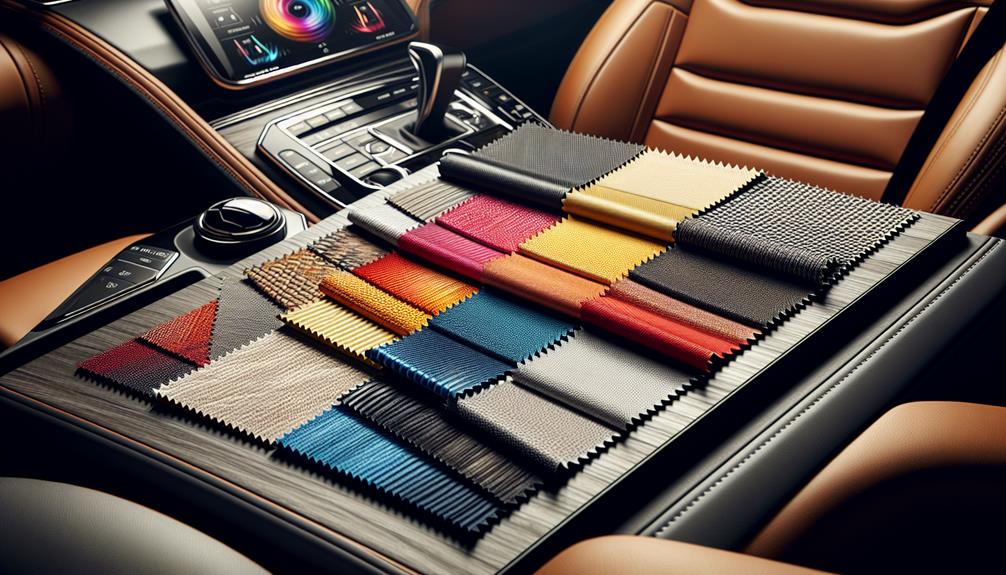You might not know that eco-friendly materials are becoming increasingly popular in automotive interiors, offering an impressive balance of sustainability and style. When selecting fabrics, you'll need to weigh options like leather, synthetic blends, and these newer green alternatives. Each type has its unique benefits and challenges, from durability to comfort and maintenance. Understanding these nuances can make a significant difference in your vehicle's long-term appeal and value. So, what exactly should you prioritize to guarantee your car's interior remains both functional and appealing over time?
Table of Contents
Key Takeaways
- Consider durability factors like weather resistance and high rub counts to ensure longevity.
- Evaluate comfort aspects, including breathability, texture preferences, and temperature control.
- Opt for fabric types that offer easy maintenance, such as stain-resistant and UV-resistant materials.
- Choose eco-friendly materials like organic cotton and recycled polyester for sustainability benefits.
- Prioritize premium options like leather for a high-end look and increased resale value.
Leather Options
When it comes to automotive interiors, leather options offer a blend of luxury and durability that's essential to beat. You're not just getting a seat cover; you're investing in a premium experience that enhances both aesthetics and comfort.
One of the first things you'll appreciate is the extensive range of color choices available. Whether you prefer classic black, sophisticated tan, or a bold red, there's a leather color to match your vision. Texture preferences are just as varied, from smooth and sleek to richly grained finishes, allowing you to create an interior that feels uniquely yours.
Considering cost comparisons, leather does come at a premium, but it's worth every penny if you're after a high-end look and feel. It's pivotal to weigh the initial investment against the long-term benefits, as leather is known for its resilience and ease of maintenance.
Customization options are another significant advantage. You can opt for perforated leather for better ventilation or choose contrast stitching to add a touch of flair. By selecting leather, you're not just choosing a material; you're customizing an experience that aligns perfectly with your style and needs.
Synthetic Fabrics
Synthetic fabrics offer a versatile and cost-effective alternative for automotive interiors that don't compromise on style or functionality. When you're looking to achieve a high-end look without the hefty price tag, synthetic fabrics provide exceptional value. They enable stunning custom designs that can be tailored to your exact preferences. Whether you aim for a sleek, modern feel or a more traditional aesthetic, synthetic materials can be crafted to meet your vision.
One of the standout benefits of synthetic fabrics is the wide array of color options available. You're not limited by the natural hues of leather or other materials; instead, you can choose from virtually any shade imaginable to perfectly match your vehicle's interior. This flexibility in color options makes it easier to create a cohesive and appealing design.
Texture preferences are another area where synthetic fabrics shine. From smooth, leather-like finishes to more textured, fabric-like surfaces, these materials can be engineered to provide the tactile experience you desire. They're not just about looks—synthetic fabrics also offer durability and ease of maintenance, making them a pragmatic choice for those who want both beauty and practicality in their automotive interiors.
Eco-Friendly Materials
As environmental concerns become more pressing, choosing eco-friendly materials for your automotive interiors can make a significant impact. By opting for green alternatives, you contribute to reducing the environmental impact of your vehicle.
Materials like organic cotton, recycled polyester, and natural fibers such as hemp and bamboo offer remarkable sustainability benefits without compromising on quality or aesthetics.
Eco-friendly options aren't just a trend; they're a responsible choice that helps reduce waste and conserve natural resources. Organic cotton, for instance, is grown without harmful pesticides, making it a healthier option for both the planet and the occupants of your car.
Recycled polyester repurposes plastic waste, giving it a new life and reducing landfill accumulation. Hemp and bamboo are fast-growing plants that require minimal water and no pesticides, making them excellent choices for sustainable automotive fabrics.
Incorporating these materials into your vehicle's interior can also enhance its overall appeal. Eco-friendly fabrics often possess unique textures and appearances that can set your car apart. By prioritizing green alternatives, you're not just elevating the look of your car's interior; you're making a conscious decision to protect the environment for future generations.
Durability Factors
While eco-conscious materials are an excellent choice, you also need to think about the durability of the fabrics to guarantee they withstand daily wear and tear. Choosing the right fabric secures longevity and maintains the aesthetic appeal of your vehicle's interior.
Here's what you should consider:
- Weather Resistance: Your car's interior will be exposed to various weather conditions, from scorching heat to freezing cold. Opt for fabrics that can withstand UV rays and moisture, preventing color fading and mold growth. Weather-resistant materials, like synthetic leather or treated fabrics, offer excellent protection.
- Wear and Tear: Daily use subjects your car seats and upholstery to significant stress. Fabrics like high-quality nylon and polyester blends are known for their robustness. They resist abrasions and maintain their integrity over time. Look for materials that have been tested for high rub counts to secure they can handle heavy usage.
- Color Options and Texture Preferences: Durability doesn't mean you need to compromise on style. Modern durable fabrics come in a wide array of color options and textures, allowing you to match your interior design preferences. Consider materials that offer both aesthetic versatility and toughness to meet your specific needs.
Comfort Considerations
When choosing fabrics for your car's interior, comfort should be a top priority to guarantee a pleasant driving experience. To achieve this, take into account several key factors that influence comfort: color selection, texture preferences, temperature control, and breathability features.
Firstly, the color selection of your fabric can dramatically affect the comfort level. Lighter colors tend to reflect heat, keeping the seats cooler, while darker shades absorb heat, making them warmer. Your texture preferences also play a significant role; smooth fabrics like leather provide a sleek, luxurious feel, while textured materials like cloth offer a softer, cozier experience.
Temperature control is essential for maintaining a comfortable cabin environment. Fabrics with good breathability features help regulate temperature by allowing air circulation. This prevents the seats from becoming too hot in the summer or too cold in the winter.
Here's a quick reference table to summarize these comfort considerations:
| Factor | Benefit | Examples |
|---|---|---|
| Color Selection | Heat reflection/absorption | Light colors, Dark colors |
| Texture Preferences | Luxurious or cozy feel | Leather, Cloth |
| Temperature Control | Maintains cabin temperature | Reflective fabrics |
| Breathability | Enhances air circulation | Perforated materials |
| Combined Benefits | Overall comfort improvement | Custom combinations |
Maintenance Tips
To keep your automotive fabrics looking fresh, following specific maintenance tips is crucial. Regular cleaning can prevent fabric damage, and knowing the right stain removal techniques will save you from permanent marks.
Let's explore how often you should clean and the best methods to handle spills and stains.
Cleaning Frequency Guidelines
Regularly cleaning your car's interior fabric can significantly extend its lifespan and maintain its appearance. To achieve this, you'll need to establish a consistent cleaning routine.
Here are three essential guidelines to follow:
- Choose the Right Cleaning Products: Use fabric-specific cleaning products to avoid damage. A mild detergent mixed with water often works well for DIY methods. For tougher jobs, consider professional-grade cleaners. Always check the label to guarantee compatibility with your car's fabric.
- Follow Frequency Recommendations: Generally, it's wise to clean your car's interior every two weeks. However, if you frequently transport pets, kids, or eat in your car, you might need to clean more often. Regular vacuuming can also help maintain cleanliness between deeper cleans.
- Balance DIY Methods and Professional Services: While DIY cleaning can be effective and cost-saving, don't underestimate the value of professional services. A professional deep clean every six months can reach areas and remove dirt that DIY methods might miss, ensuring your car's interior remains in top condition.
Stain Removal Techniques
Accidents happen, but with the right stain removal techniques, you can keep your car's interior looking pristine. Start with DIY methods like blotting the stain with a clean cloth and using mild soap mixed with water. For tougher stains, consider a specialized automotive cleaner. Always test a small, inconspicuous area first to avoid damaging the fabric.
Preventative measures are vital. Apply fabric protectors to shield against spills and stains. These protectors create a barrier, making it easier to clean up messes before they set in. Regularly vacuuming your car's interior also helps prevent dirt buildup, which can lead to stains.
For emergency solutions, keep a stain removal kit in your car. This kit should include items like absorbent cloths, a small spray bottle of water, mild soap, and a portable fabric cleaner. Acting quickly can make all the difference in preventing a stain from becoming permanent.
When DIY methods fall short, don't hesitate to seek professional services. Professional cleaners have the expertise and specialized equipment to tackle stubborn stains without damaging your car's interior. By combining these techniques, you can maintain a spotless and inviting automotive environment.
Frequently Asked Questions
How Does Fabric Choice Affect Vehicle Resale Value?
Did you know long-lasting fabrics can boost resale value by up to 10%? Fabric durability directly impacts your vehicle's resale value. Selecting high-quality materials guarantees a longer-lasting, more attractive interior, making your car more appealing to buyers.
Are There Hypoallergenic Fabric Options for Car Interiors?
Yes, there are hypoallergenic, eco-friendly options that offer both durability and a pleasant texture. These fabrics require minimal maintenance, making them perfect for those who want a healthy, sustainable, and easy-to-care-for car interior.
What Are the Latest Trends in Automotive Interior Fabrics?
Oh, you mean you don't already know? Well, the latest trends include sustainable materials and performance fabrics. Everyone's raving about luxury textures and custom designs. It's like you need a degree to choose car fabrics now!
How Do Fabric Colors Impact the Perception of Interior Space?
Fabric colors greatly impact your perception of interior space. By leveraging color psychology, you can make spaces feel larger or cozier. Light colors enhance spatial perception, creating openness, while dark colors provide a more intimate, enclosed feel.
Can Fabric Choices Influence Car Cabin Noise Levels?
Sure, because who doesn't love a roaring engine over their favorite podcast? Your fabric selection can indeed influence noise reduction. Opt for soundproofing fabrics to enhance comfort and keep your cabin blissfully quiet.
- How to Get Wrinkles Out of a Crepe Dress (4 Methods, No Iron Needed!) - June 23, 2025
- Can You Put Crepe in the Dryer? The Definitive Answer - June 23, 2025
- How to Wash Crepe Fabric (Hand Wash & Machine Wash Instructions) - June 23, 2025







